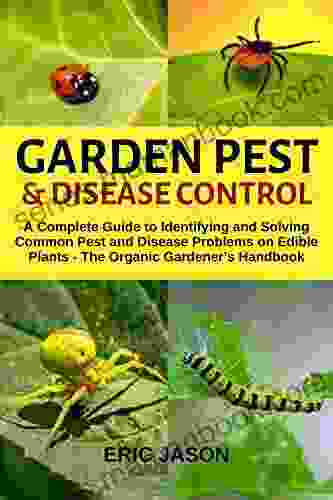Comprehensive Guide to Garden Pest and Disease Control: Prevention, Identification, and Organic Solutions

A thriving garden is a source of pride and joy for any gardener. However, pests and diseases can quickly turn a beautiful garden into a nightmare. Pests can devour leaves, stems, and flowers, while diseases can cause plants to wilt, yellow, and die.
Fortunately, there are a number of things you can do to prevent and control pests and diseases in your garden. In this article, we will discuss the different types of pests and diseases that can affect plants, how to identify them, and how to control them using organic methods.
There are a wide variety of pests that can affect plants in the garden. Some of the most common include:
4.4 out of 5
| Language | : | English |
| File size | : | 540 KB |
| Text-to-Speech | : | Enabled |
| Screen Reader | : | Supported |
| Enhanced typesetting | : | Enabled |
| Print length | : | 132 pages |
| Lending | : | Enabled |
- Aphids: Aphids are small, soft-bodied insects that suck the sap from plants. They can cause leaves to curl and distort, and they can also transmit diseases.
- Cabbage loopers: Cabbage loopers are green caterpillars that feed on the leaves of cabbage, broccoli, and cauliflower. They can cause severe damage to plants, especially if they are young.
- Codling moths: Codling moths are small, brown moths that lay their eggs on apples and pears. The larvae hatch and bore into the fruit, causing it to rot.
- Cucumber beetles: Cucumber beetles are small, yellow and black beetles that feed on the leaves and flowers of cucumbers, melons, and squash. They can also transmit diseases.
- Fleas: Fleas are small, wingless insects that feed on the blood of animals. They can also transmit diseases to humans and animals.
- Japanese beetles: Japanese beetles are large, metallic green beetles that feed on the leaves of a wide variety of plants. They can cause severe damage to plants, especially if they are young.
- Slugs: Slugs are slimy, slow-moving creatures that feed on the leaves of plants. They can cause significant damage to plants, especially during wet weather.
- Spider mites: Spider mites are tiny, spider-like creatures that suck the sap from plants. They can cause leaves to turn yellow and drop off.
- Thrips: Thrips are small, slender insects that feed on the flowers and leaves of plants. They can cause flowers to become distorted and discolored.
- Whiteflies: Whiteflies are small, white insects that feed on the sap of plants. They can cause leaves to turn yellow and drop off.
There are also a number of diseases that can affect plants in the garden. Some of the most common include:
- Bacterial blight: Bacterial blight is a disease that causes leaves to turn brown and wilt. It can affect a wide variety of plants, including tomatoes, peppers, and beans.
- Botrytis blight: Botrytis blight is a disease that causes flowers and stems to rot. It can affect a wide variety of plants, including roses, lilies, and tulips.
- Downy mildew: Downy mildew is a disease that causes leaves to turn yellow and develop a white or gray mold. It can affect a wide variety of plants, including cucumbers, melons, and squash.
- Fusarium wilt: Fusarium wilt is a disease that causes plants to wilt and die. It can affect a wide variety of plants, including tomatoes, peppers, and eggplants.
- Powdery mildew: Powdery mildew is a disease that causes leaves to develop a white or gray powdery coating. It can affect a wide variety of plants, including roses, lilies, and tomatoes.
- Rust: Rust is a disease that causes leaves to develop orange or brown pustules. It can affect a wide variety of plants, including roses, beans, and soybeans.
- Scab: Scab is a disease that causes fruits and vegetables to develop scabby lesions. It can affect a wide variety of plants, including apples, pears, and potatoes.
- Verticillium wilt: Verticillium wilt is a disease that causes plants to wilt and die. It can affect a wide variety of plants, including trees, shrubs, and flowers.
The first step to controlling pests and diseases is to correctly identify them. This can be done by observing the symptoms on plants and using a reference guide or consulting with a professional.
Once you have identified the pest or disease, you can develop a plan to control it.
There are a number of organic methods that can be used to control pests and diseases in the garden. Some of the most common include:
- Companion planting: Companion planting is a technique that involves planting different species of plants together to help each other grow and protect each other from pests and diseases. For example, planting onions near carrots can help to repel carrot flies.
- Crop rotation: Crop rotation is a technique that involves planting different types of crops in the same area in successive years. This helps to break the life cycle of pests and diseases that are specific to certain crops.
- Cover crops: Cover crops are plants that are grown to cover the soil and suppress weeds. They can also help to attract beneficial insects that prey on pests.
- Mulching: Mulching is a technique that involves spreading organic material, such as straw or compost, around plants. This helps to retain moisture, suppress weeds, and protect plants from pests and diseases.
- Organic pesticides: There are a number of organic pesticides that can be used to control pests and diseases in the garden. Some of the most common include neem oil, insecticidal soap, and horticultural oil.
Pests and diseases are a common problem in the garden, but they can be controlled using organic methods. By following the tips in this article, you can keep your garden healthy and pest-free.
4.4 out of 5
| Language | : | English |
| File size | : | 540 KB |
| Text-to-Speech | : | Enabled |
| Screen Reader | : | Supported |
| Enhanced typesetting | : | Enabled |
| Print length | : | 132 pages |
| Lending | : | Enabled |
Do you want to contribute by writing guest posts on this blog?
Please contact us and send us a resume of previous articles that you have written.
 Top Book
Top Book Novel
Novel Fiction
Fiction Nonfiction
Nonfiction Literature
Literature Paperback
Paperback Hardcover
Hardcover E-book
E-book Audiobook
Audiobook Bestseller
Bestseller Classic
Classic Mystery
Mystery Thriller
Thriller Romance
Romance Fantasy
Fantasy Science Fiction
Science Fiction Biography
Biography Memoir
Memoir Autobiography
Autobiography Poetry
Poetry Drama
Drama Historical Fiction
Historical Fiction Self-help
Self-help Young Adult
Young Adult Childrens Books
Childrens Books Graphic Novel
Graphic Novel Anthology
Anthology Series
Series Encyclopedia
Encyclopedia Reference
Reference Guidebook
Guidebook Textbook
Textbook Workbook
Workbook Journal
Journal Diary
Diary Manuscript
Manuscript Folio
Folio Pulp Fiction
Pulp Fiction Short Stories
Short Stories Fairy Tales
Fairy Tales Fables
Fables Mythology
Mythology Philosophy
Philosophy Religion
Religion Spirituality
Spirituality Essays
Essays Critique
Critique Commentary
Commentary Glossary
Glossary Bibliography
Bibliography Index
Index Table of Contents
Table of Contents Preface
Preface Introduction
Introduction Foreword
Foreword Afterword
Afterword Appendices
Appendices Annotations
Annotations Footnotes
Footnotes Epilogue
Epilogue Prologue
Prologue Dale Strickler
Dale Strickler Stephan Weaver
Stephan Weaver Cd Reiss
Cd Reiss Gosho Aoyama
Gosho Aoyama Erin Litteken
Erin Litteken Michael J Foy
Michael J Foy Sven Beckert
Sven Beckert Sara James
Sara James Brian Shaw
Brian Shaw Simon Warwick Beresford
Simon Warwick Beresford Tamar Hermes
Tamar Hermes Anthony Hecht
Anthony Hecht Kindle Edition
Kindle Edition Jayne Louise
Jayne Louise Jennifer Casa Todd
Jennifer Casa Todd Sumi Hahn
Sumi Hahn Jennifer Robertson
Jennifer Robertson Jennifer Tremblay
Jennifer Tremblay Garden Knits
Garden Knits Judy Cox
Judy Cox
Light bulbAdvertise smarter! Our strategic ad space ensures maximum exposure. Reserve your spot today!

 Gabriel HayesHow Big Government Liberals Wrecked The Global Economy And How They Will Do...
Gabriel HayesHow Big Government Liberals Wrecked The Global Economy And How They Will Do...
 Dylan MitchellDaily Exercises for Beginners and Advanced Players: Essential Exercises for a...
Dylan MitchellDaily Exercises for Beginners and Advanced Players: Essential Exercises for a... Bobby HowardFollow ·13.9k
Bobby HowardFollow ·13.9k Troy SimmonsFollow ·12.5k
Troy SimmonsFollow ·12.5k Jarrett BlairFollow ·6.9k
Jarrett BlairFollow ·6.9k Dan BellFollow ·19.5k
Dan BellFollow ·19.5k Dustin RichardsonFollow ·15.8k
Dustin RichardsonFollow ·15.8k Mark TwainFollow ·7.3k
Mark TwainFollow ·7.3k Terry PratchettFollow ·12.2k
Terry PratchettFollow ·12.2k Mikhail BulgakovFollow ·16.7k
Mikhail BulgakovFollow ·16.7k

 David Mitchell
David MitchellMy Surly Heart: Poetic Expressions of Unrequited Love...
In the annals of...

 Jake Carter
Jake CarterBleach Vol. 50: The Six Fullbringers - A Comprehensive...
Bleach Vol. 50, titled "The Six...

 Edward Reed
Edward ReedThe Art of Simple Food II: A Masterclass in Culinary...
In an era of culinary excess, where meals...

 Jarrett Blair
Jarrett BlairThe Easy Ingredient Ketogenic Diet Cookbook: Your Gateway...
The ketogenic diet,...

 Larry Reed
Larry ReedThe Very Edge Poems Polly Alice Mccann: A Poetic...
An to 'The Very...

 Sidney Cox
Sidney CoxThe Keys of Death and Hades: Unlocking the Epic of...
In the realm of mythology...
4.4 out of 5
| Language | : | English |
| File size | : | 540 KB |
| Text-to-Speech | : | Enabled |
| Screen Reader | : | Supported |
| Enhanced typesetting | : | Enabled |
| Print length | : | 132 pages |
| Lending | : | Enabled |








